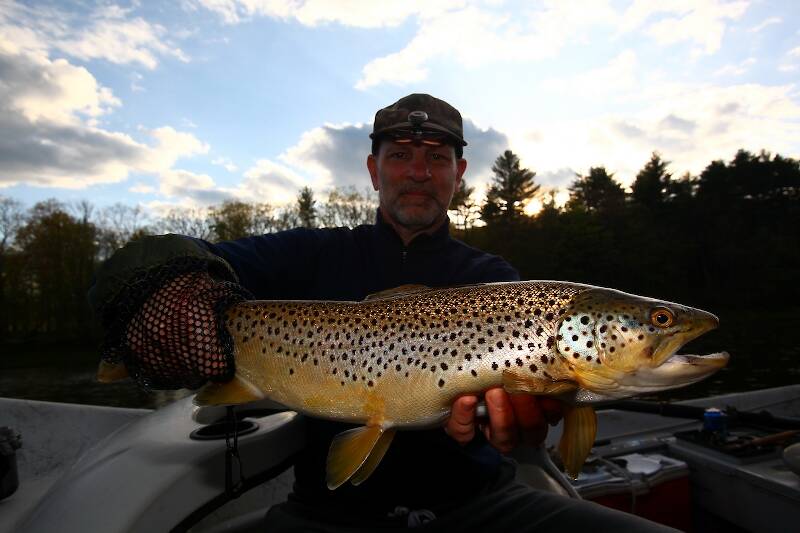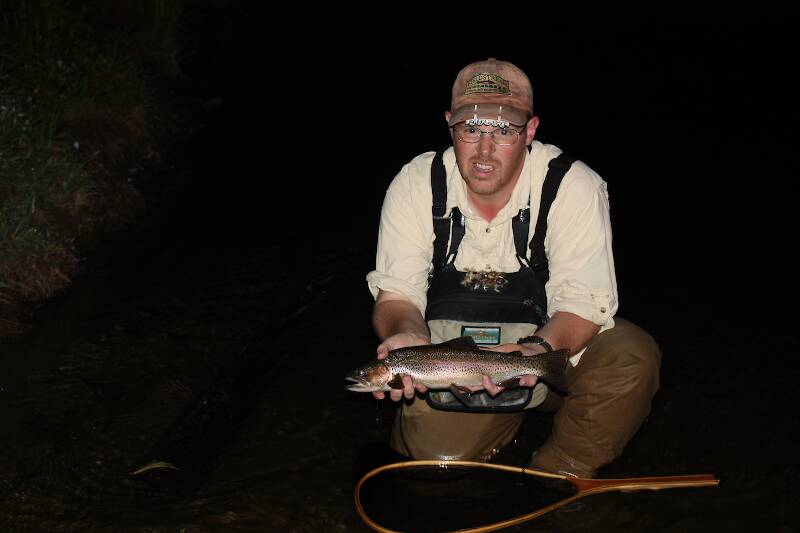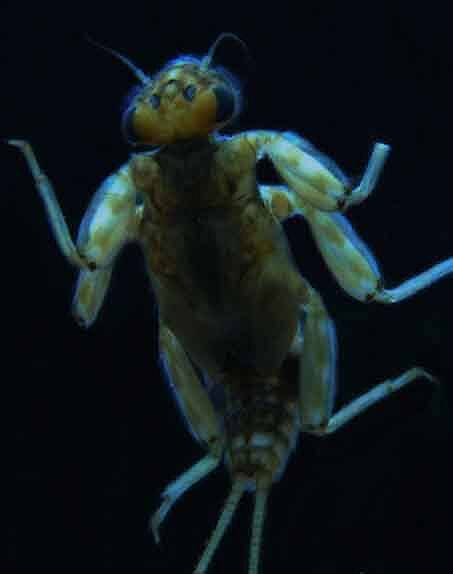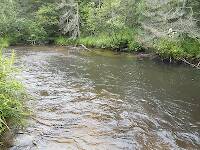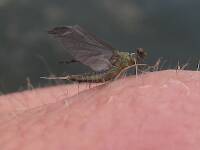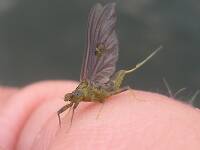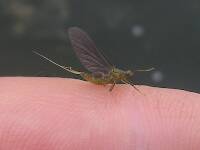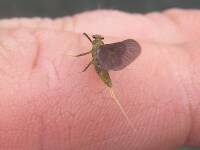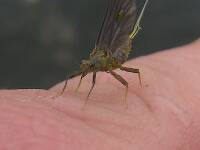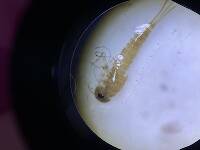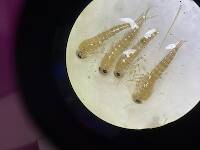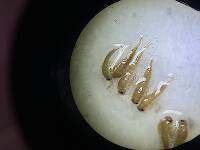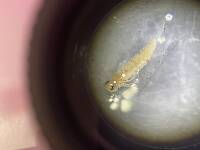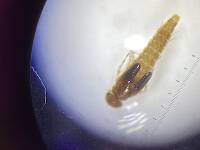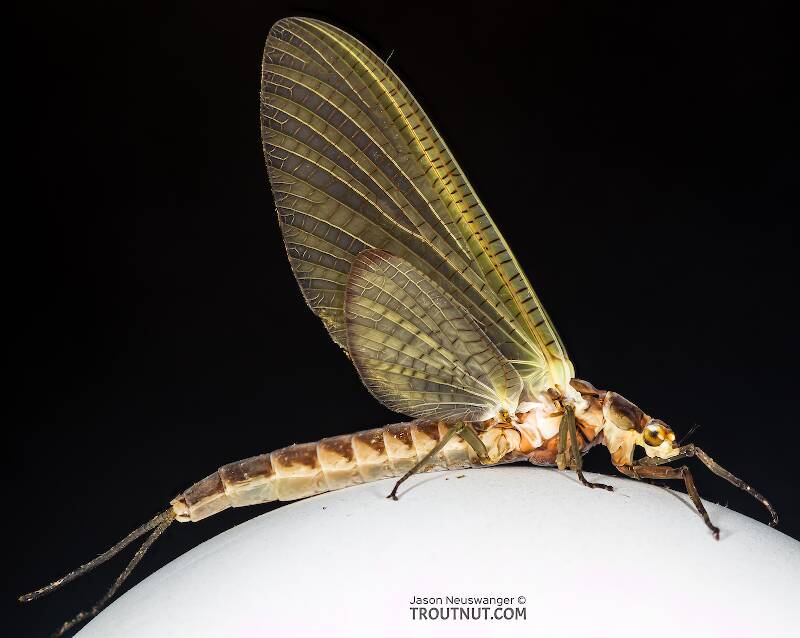
Hex Mayflies
Hexagenia limbata
The famous nocturnal Hex hatch of the Midwest (and a few other lucky locations) stirs to the surface mythically large brown trout that only touch streamers for the rest of the year.
Featured on the forum
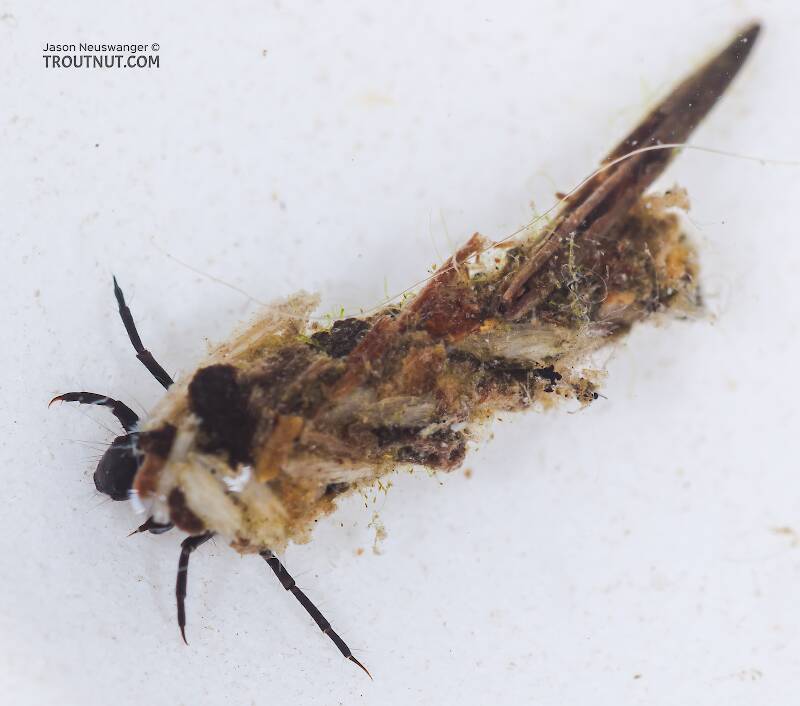
This seems to be a young larva of Limnephilus. Although not clear in the picture, several ventral abdominal segments have chloride epithelia.
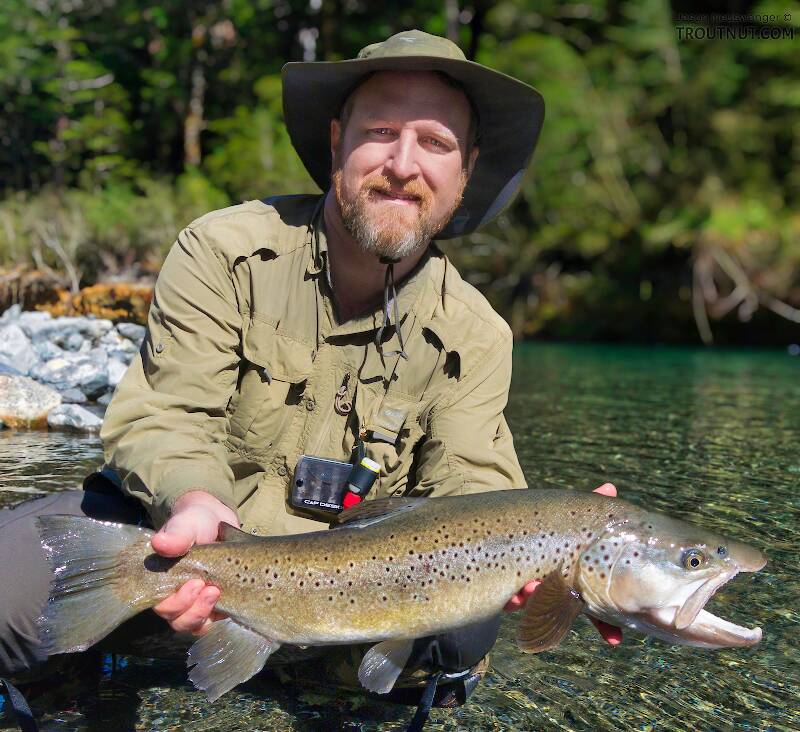
Troutnut is a project started in 2003 by salmonid ecologist Jason "Troutnut" Neuswanger to help anglers and
fly tyers unabashedly embrace the entomological side of the sport. Learn more about Troutnut or
support the project for an enhanced experience here.
Martinlf on Jun 19, 2007June 19th, 2007, 2:24 pm EDT
Caddisman, JW, or any other PA anglers--have you seen any Tricos yet? I believe they're coming off on the Little Lehigh. I'll check Rod's website to be sure. Time to pull out the itsie bitsies and dust them off.
"He spread them a yard and a half. 'And every one that got away is this big.'"
--Fred Chappell
--Fred Chappell
JAD on Jun 20, 2007June 20th, 2007, 4:02 am EDT
Hi Newt
No I haven't but my hands are getting itchy :) Cindi and I will be at Penns this weekend at that A frame, that I was telling you about,Ill be fishing in the mornings I'll keep an eye open.
Louis I just got a great idea--This hole group on here could rent this A frame together. I know Dick rents this out to the right people, its only half a mile from Penns. (Just a Thought)
They fasten red (crimson red) wool around a hook, and fix onto the wool two feathers which grow under a cock’s wattles, and which in colour are like wax.
Radcliffe's Fishing from the Earliest Times,
Troutnut on Jun 20, 2007June 20th, 2007, 5:06 am EDT
Anyone care to fill me in on the 'Newt' joke?
Jason Neuswanger, Ph.D.
Troutnut and salmonid ecologist
Troutnut and salmonid ecologist
JOHNW on Jun 20, 2007June 20th, 2007, 10:09 am EDT
Have not seen any trikes yet but I had the #22-26 hooks in the vice getting my stocks replenished. I forgot how frustrating it is to split tails on something that stinking small.
JW
JW
"old habits are hard to kill once you have gray in your beard" -Old Red Barn
Troutnut on Jun 20, 2007June 20th, 2007, 11:00 am EDT
JW, what splitting method do you use? I generally don't have too much trouble splitting them with the Thread-spread Triple Tail method (#24 on p. 84 of the Benchside Reference). In the book it sounds more complicated than it is.
Jason Neuswanger, Ph.D.
Troutnut and salmonid ecologist
Troutnut and salmonid ecologist
Martinlf on Jun 20, 2007June 20th, 2007, 11:09 am EDT
Jason, the reference to Newt comes from my uncle's favorite big fish expression, "Hold her Newt, she's headed for the pea patch." Caddisman, I like the idea--especially for olive season or sulphurs. Let's keep it in mind.
"He spread them a yard and a half. 'And every one that got away is this big.'"
--Fred Chappell
--Fred Chappell
JOHNW on Jun 21, 2007June 21st, 2007, 8:35 am EDT
Jason,
I use the split thread technique. I think the tough part came from switching from tying #4-2/0 bass streamers to the ultra tiny trikes. It took four or five for me to get the proportions and techniques scaled back down, but then that is what they make razor blades for.
Caddisman,
Have done a very similar thing, including my first and only trip to Yellowstone, with guys from the "other board" and it always worked out well.
JW
I use the split thread technique. I think the tough part came from switching from tying #4-2/0 bass streamers to the ultra tiny trikes. It took four or five for me to get the proportions and techniques scaled back down, but then that is what they make razor blades for.
Caddisman,
Have done a very similar thing, including my first and only trip to Yellowstone, with guys from the "other board" and it always worked out well.
JW
"old habits are hard to kill once you have gray in your beard" -Old Red Barn
JAD on Jun 25, 2007June 25th, 2007, 1:01 am EDT
Louis
No Tricos from what I saw,Olives and Slate Drakes.
jaD
They fasten red (crimson red) wool around a hook, and fix onto the wool two feathers which grow under a cock’s wattles, and which in colour are like wax.
Radcliffe's Fishing from the Earliest Times,
IEatimago on Jun 30, 2007June 30th, 2007, 3:53 am EDT
on penns and honey creek i am seeing bwo's
on penns i have been seeing light cahill? maybe is the slate drake, cause the fish weren't taking the light cahill i was pitching.
but the bwo produced nicely
edit because i named the wrong creek
on penns i have been seeing light cahill? maybe is the slate drake, cause the fish weren't taking the light cahill i was pitching.
but the bwo produced nicely
edit because i named the wrong creek
JOHNW on Jun 30, 2007June 30th, 2007, 4:23 pm EDT
Slate drakes (Isonychia) are a big (#12 or bigger this early) and dark bug very tough to miss. Cahills are about as opposite in color as you can get from an Iso.
If they are taking BWO I would guess the Cornutta is a good candidate for the specific bug.
Just my humble $.02
JW
If they are taking BWO I would guess the Cornutta is a good candidate for the specific bug.
Just my humble $.02
JW
"old habits are hard to kill once you have gray in your beard" -Old Red Barn
GONZO on Jul 1, 2007July 1st, 2007, 9:51 am EDT
Louis,
At the PFFMA Heritage Day back on 6/16, I heard reports of tricos hatching. I know that they're often confused for paraleps spinners at that time of year, but the fellow I talked to seemed exceptionally bug-conscious. He also had pictures of some slob rainbows taken during the spinner fall. I'm pretty sure that the rainbows were Beaver brutes, so I assumed he was fishing around Spruce at the time.
At the PFFMA Heritage Day back on 6/16, I heard reports of tricos hatching. I know that they're often confused for paraleps spinners at that time of year, but the fellow I talked to seemed exceptionally bug-conscious. He also had pictures of some slob rainbows taken during the spinner fall. I'm pretty sure that the rainbows were Beaver brutes, so I assumed he was fishing around Spruce at the time.
JOHNW on Jul 2, 2007July 2nd, 2007, 9:49 am EDT
Gonzo,
Don't forget about Yellow as a possible venue for those big bows.
I hope to do a little scouting the next day or so and see if the "little devils" are about.
JW
Don't forget about Yellow as a possible venue for those big bows.
I hope to do a little scouting the next day or so and see if the "little devils" are about.
JW
"old habits are hard to kill once you have gray in your beard" -Old Red Barn
GONZO on Jul 2, 2007July 2nd, 2007, 1:14 pm EDT
Don't forget about Yellow as a possible venue for those big bows.
You're right, John; I suppose it could have been most any of the "Beaverized" streams. If an out-of-stater paid attention to all of the trumped-up publicity (magazine covers, catalog photos, television fly-fishing competitions, etc.) it would be hard to escape the erroneous conclusion that PA is a producer of huge rainbows. That's kind of ironic since your home stream and the Delaware are among the very few streams where that is remotely true. I'm not sure why I bridle at that mistaken impression, but I do.
JAD on Jul 2, 2007July 2nd, 2007, 2:20 pm EDT
(Quote) Louis,
At the PFFMA Heritage Day back on 6/16, I heard reports of tricos hatching. I know that they're often confused for paraleps spinners at that time of year, but the fellow I talked to seemed exceptionally bug-conscious. He also had pictures of some slob rainbows taken during the spinner fall. I'm pretty sure that the rainbows were Beaver brutes, so I assumed he was fishing
Lloyd I have been using (small black), and doing very well on 20 and smaller black spinner at Barrie and below. Their has been a small very dark BWO comming for some time ( around a month) along with the Paralops---
JaD
At the PFFMA Heritage Day back on 6/16, I heard reports of tricos hatching. I know that they're often confused for paraleps spinners at that time of year, but the fellow I talked to seemed exceptionally bug-conscious. He also had pictures of some slob rainbows taken during the spinner fall. I'm pretty sure that the rainbows were Beaver brutes, so I assumed he was fishing
Lloyd I have been using (small black), and doing very well on 20 and smaller black spinner at Barrie and below. Their has been a small very dark BWO comming for some time ( around a month) along with the Paralops---
JaD
They fasten red (crimson red) wool around a hook, and fix onto the wool two feathers which grow under a cock’s wattles, and which in colour are like wax.
Radcliffe's Fishing from the Earliest Times,
GONZO on Jul 3, 2007July 3rd, 2007, 4:29 am EDT
Hi John,
Thanks for the update. In addition to the reports of early trico hatches, there are several other small darkish mayflies that can provide morning action at this time of year. The paraleps/blue quills tend to be late morning emergers and the male spinners (unlike the early season blue quills) often have the "Jenny spinner" configuration--whitish abdomens with dark tips. Little olive morning duns (the second, smaller cohort of Drunella lata) and little black quills (Serratella deficiens) can also be important. And, of course, baetids can show up most anytime. Have you noticed if the dark BWOs you mentioned have two tails or three?
Thanks for the update. In addition to the reports of early trico hatches, there are several other small darkish mayflies that can provide morning action at this time of year. The paraleps/blue quills tend to be late morning emergers and the male spinners (unlike the early season blue quills) often have the "Jenny spinner" configuration--whitish abdomens with dark tips. Little olive morning duns (the second, smaller cohort of Drunella lata) and little black quills (Serratella deficiens) can also be important. And, of course, baetids can show up most anytime. Have you noticed if the dark BWOs you mentioned have two tails or three?
JAD on Jul 3, 2007July 3rd, 2007, 7:03 am EDT
No I did not count tails, I get my samples from the Cob Webs off the bridge at Barrie. I'll be their this Thursday I'll check. I never thought about the Black Quill ,have only run in to them on Young-Womens Creek and they were much larger.So what I saw might not have been BWO.
I noted to my friend that I had never seen any that dark--HuH
Ill get back to you on this.
JAD
They fasten red (crimson red) wool around a hook, and fix onto the wool two feathers which grow under a cock’s wattles, and which in colour are like wax.
Radcliffe's Fishing from the Earliest Times,
GONZO on Jul 3, 2007July 3rd, 2007, 3:06 pm EDT
Thanks, John, I'll await your report. I also think I may have confused you with my reference to "little black quills." Black quill is the common name for Leptophlebia cupida, a larger unrelated spring emerger. Little black quill is my name for Serratella deficiens. I use the name because it seems more descriptive of the little (#20) black-winged, black-bodied duns than the other common name for Serratella species, the little dark Hendricksons. (Jason mentions another appropriate name that is apparently used in his old Midwestern stomping grounds, Darth Vader.) The deficiens duns have light rings around their abdomen, giving them a quill-bodied look. The legs and tails of the duns are very pale, and the dark little nymphs have the habit of flipping their abdomens skyward in a scorpionlike posture. This is not a well-known hatch, but it is very widespread and can be important on many streams.
IEatimago on Jul 3, 2007July 3rd, 2007, 3:32 pm EDT
the bwo's i have collected recently have 3 tails,
if you would like me to post a picture i can try, allthough the fluid i used to preserve these bugs is garbage and they slightly fade in color.
so stay away from "bug balmer"
if you would like me to post a picture i can try, allthough the fluid i used to preserve these bugs is garbage and they slightly fade in color.
so stay away from "bug balmer"
GONZO on Jul 3, 2007July 3rd, 2007, 3:42 pm EDT
Were the three-tailed "BWOs" emerging in the morning? If so, they are probably Drunella. The nymphs are pretty distinctive; they have the typical crawler shape with noticeably fat and flattened front-leg femurs.
Konchu on Jul 3, 2007July 3rd, 2007, 3:42 pm EDT
Haven't heard of S. deficiens being called by a Star Wars name before. However, a new genus and species of mayfly was recently described from Borneo by colleagues:
Darthus vadorus
I am not making this up.
Darthus vadorus
I am not making this up.
Quick Reply
Related Discussions
Topic
Replies
Last Reply
10
Dec 18, 2013
by Brookyman
by Brookyman
7
May 12, 2008
by GONZO
by GONZO
4
May 24, 2008
by Softhackle
by Softhackle


